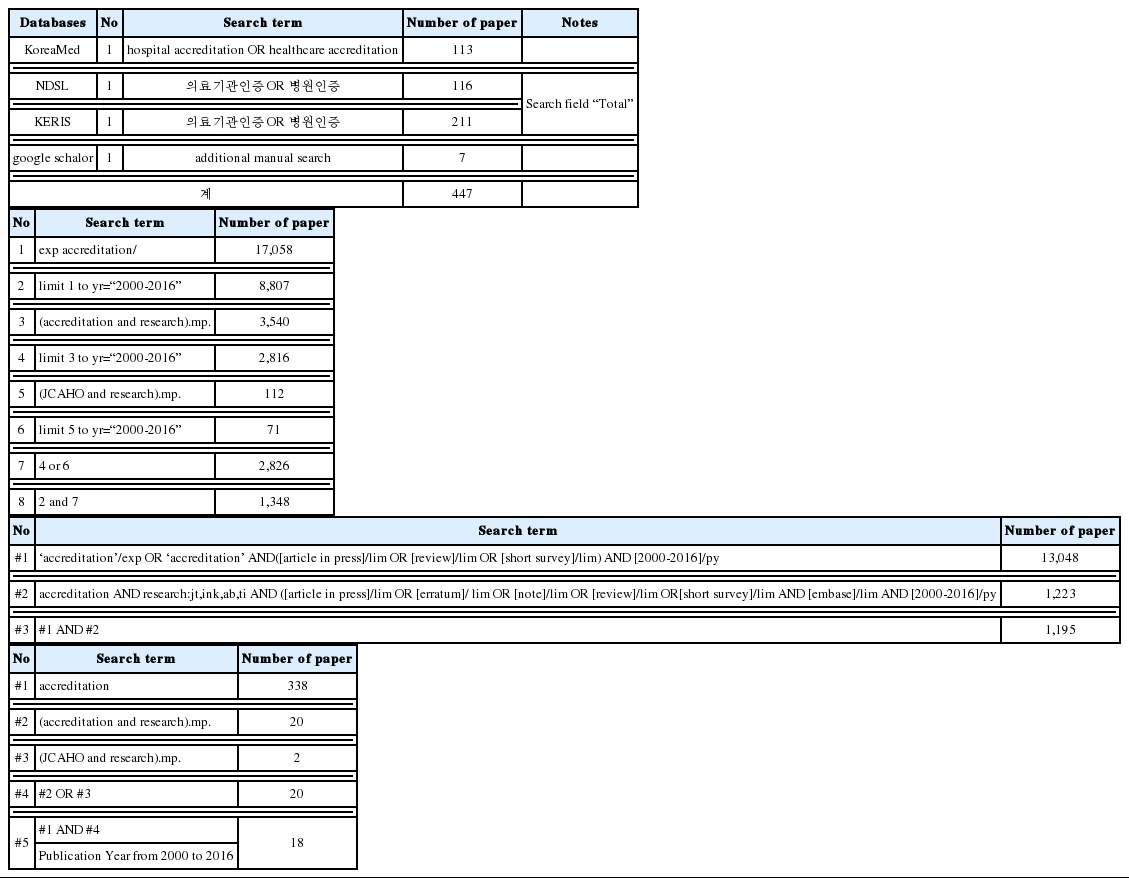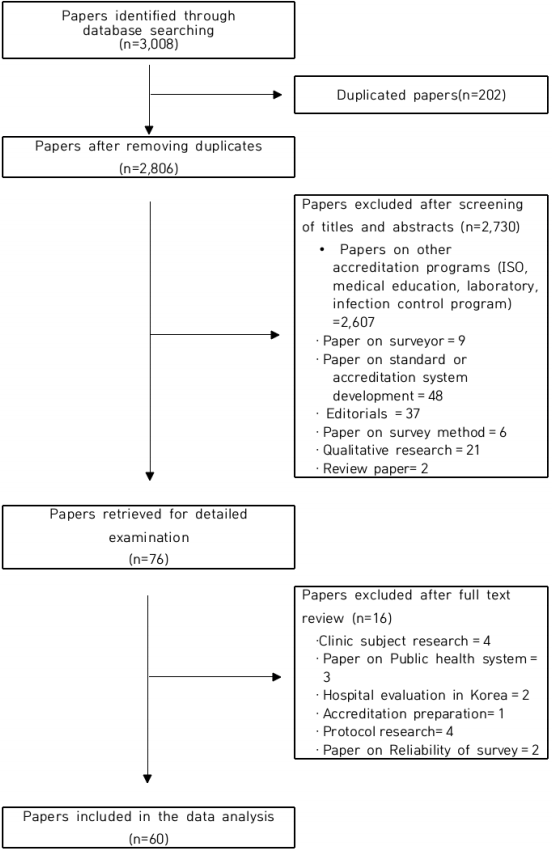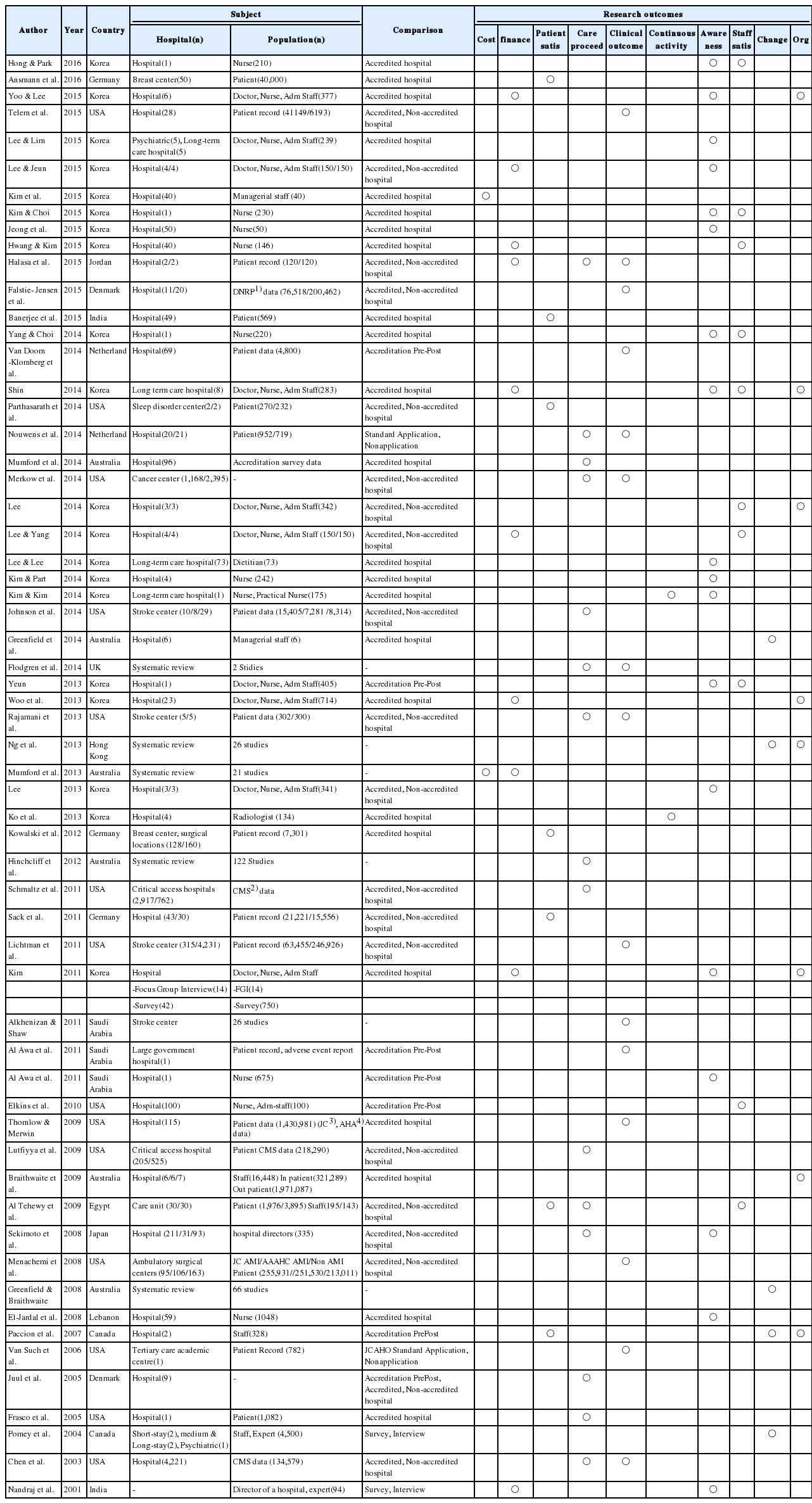의료기관인증의 효과에 대한 체계적 문헌고찰: Balanced Score Card 관점으로
Impact of Healthcare Accreditation Using a Systematic Review: Balanced Score Card Perspective
Article information
Trans Abstract
Purpose
The purpose of this study was to analyze the impact of healthcare accreditation and to provide empirical evidence to validate positive effectiveness.
Methods
Six electronic databases (KERIS, KoreaMed, NDSL, Ovid-medline, Embase, Cochrane library) were accessed in May 2016. Keywords used were ‘accreditation’ and ‘Joint Commission on Accreditation of Healthcare Organization (JCAHO)’. Of the initially identified 3,008 articles, 60 studies on healthcare accreditation were selected based on inclusion criteria that are hospital accreditation, accreditation by disease and clinical center accreditation. These were retrieved and analyzed.
Result
The 60 study results were on the impact of healthcare accreditation. Results were classified into four perspectives of Balanced Score Card (Financial, Customer, Internal Process, Learning & Growth). In internal process perspective, results revealed that healthcare accreditation has made a positive impact on “care process and procedure”. In learning & growth perspective, healthcare accreditation has made a positive influence on “leadership”, “organizational cultures” and “change mechanisms”. However, it revealed that healthcare accreditation does not directly affect financial performance. It is also difficult to reach a definitive conclusion that healthcare accreditation programs affect patient satisfaction of customer and clinical outcome of the internal process.
Conclusion
Healthcare accreditation programs provide positive impact on change of care process and building communication-oriented hospital culture. However, more rigorous and diverse research is needed on financial effects and clinical outcomes of healthcare accreditation.
Ⅰ. 서론
1. 연구의 필요성
의료기관인증은 의료시스템을 향상시키고 의료의 질을 평가하는 도구로써 널리 인식되어[1], 의료의 질을 보장하고 향상시키기 위한 효과적인 전략으로 세계 여러 나라에서 시행되고 있다[2-4].
의료기관인증제도는 1917년 미국외과학회에서 병원 표준화 프로그램을 수립한 후 1951년 병원인증독립기구인 Joint Commission on Accreditation of Hospital을 조직한 것이 시초이며, 미국을 시작으로 호주, 캐나다, 영국 등 전 세계적으로 확산되었다[5]. 세계 주요 국가의 경우 이미 오래전부터 의료기관에 대한 평가 및 인증을 담당하는 정부 혹은 민간기구들을 운영하고 있는데, 미국의 The Joint Commission (TJC), 호주의 Australian Council on Healthcare Standards (ACHS), 캐나다의 Accreditation Canada (AC) 등이 대표적이다[6]. 이들 인증기구들은 환자안전 보장 및 의료의 질 향상이라는 목표 하에 운영되며, 의료기관인증이 의료기관의 장기적·긍정적 변화를 촉진하여, 질 높은 의료와 안전한 의료를 소비자에게 제공하도록 하는 것을 목적으로 하고 있다[7].
국내의 의료기관인증은 2004년부터 시행한 의료기관평가가 객관성 및 공정성 확보 미흡, 평가결과 서열화에 따른 의료기관 간 과열경쟁 등의 문제가 제기되면서 전문성·독립성·자율성이 담보된 제도개선에 대한 논의가 촉구되었고, 보건복지부는 2010년 7월 의료법을 개정하여 자율신청제인 의료기관 인증제도를 도입하였다. 또한 서비스 공급자, 수요자, 전문가, 정부 등이 참여하는 인증 전담 기구인 의료기관평가인증원이 설립되어 2010년 11월에 인증조사가 시작되었다[8,9].
국내의 의료기관인증제는 의료법 58조에 근거한 제도로, 급성기 병원은 자율신청제이며, 요양병원과 정신병원은 의무적으로 인증을 시행하여야 한다. 자율인증, 의무인증 모두 4년 주기이며, 매년 자체적으로 중간자체 조사를 시행하게 하여 의료기관의 지속적인 질 관리를 유도하고 있다.
그러나 여러 나라에서 의료기관인증이 시행되고 있음에도 불구하고, 인증과 임상결과, 인증과 의료기관의 성과 측면에 대한 연구가 미흡하며, 인증의 도입 효과도 주관적이거나 개별적인 결과로 객관화시키기 어렵다[7, 10]. 의료기관인증의 효과를 객관적으로 입증하기 위해서 인증을 받은 병원들의 변화에 대한 구체적이고 객관적인 결과를 도출하여 제시하는 과정이 절대적으로 필요하다[10]. 체계적 문헌고찰은 현재까지 발표되었던 관련 결과를 체계적으로 종합하여 결론을 도출하는 방법이다. 본 연구에서는 인증과 관련된 연구를 종합하여, 체계적 문헌고찰 방법을 통해 의료기관인증의 효과를 다루어 보고자 한다.
의료기관인증의 효과는 재무적 성과 뿐만 아니라, 의료의 질, 환자안전과 같은 무형자산을 추구하는 것이 궁극적인 목표이므로, Balanced Score Card (BSC) 성과관리체계 이론을 연구의 기틀로 분석하였다. BSC 성과관리 이론은 Kaplan과 Norton에 의해 Harvard Business Review에 의해 처음 소개된 성과관리체계 이론으로, 성과평가의 방법에 있어서 재무적 성과 측정 이외에 무형자산에 대한 평가개념을 도입하여 성과평가 방법을 업그레이드하는 개념으로 출발하였다[11].
따라서, 본 연구에서는 의료기관인증의 효과를 BSC 성과관리 이론의 재무적 관점, 고객관점, 내부 프로세스 관점, 학습성장 관점에서 체계적 문헌고찰 방법을 통해 살펴보았다.
2. 연구목적
체계적인 문헌고찰을 통해 BSC 성과관리 이론의 재무적 관점, 고객 관점, 내부 프로세스 관점, 학습성장 관점에서 의료기관인증의 효과를 비교·분석하는 것이다.
Ⅱ. 연구 방법
1. 연구설계
본 연구는 의료기관인증의 효과에 대한 체계적 문헌고찰 연구이다.
2. 핵심질문
대상(population): 급성기병원, 요양병원, 정신병원, 진료센터, 질환별 인증
중재(intervention): 의료기관인증 프로그램
비교(comparators): 인증병원과 미인증 병원비교, 인증병원의 인증 전·후 비교, 인증기준 적용군 및 미적용군, 첫 번째 인증병원 및 재인증 병원 비교
결과(outcomes): 비용, 재무적 영향, 환자만족도, 치료과정 및 절차에 미치는 영향, 임상결과에 미치는 영향, 인증 후 기준 수행 지속성, 의료기관종사자의 인식 및 태도, 직원만족도, 변화의 메카니즘, 조직에 미치는 영향
3. 문헌검색전략
본 연구의 문헌검색은 국내 데이터베이스인 학술연구정보서비스(KERIS), KoreaMed 및 과학기술정보통합서비스(NDSL)와 국외 데이터베이스인 Ovid-medline, Embase, Cochrane library를 통해 시행하였다. 검색은 2016년 5월 18일 부터 24일까지 진행되었다. 국내 데이터 베이스를 이용한 검색은 ‘의료기관인증’ 또는 ‘병원인증’을 주요 검색어로, 주제어, 논문명 등에 해당하는 문헌을 검색하였으며, ‘환자안전’ 또는 ‘의료질 향상’으로 추가 검색하였다. 또한 구글 스칼라를 통해 의료기관인증 관련 문헌을 검색하였다. 국외 데이터 베이스를 이용한 검색은 Mesh term인 ‘accreditation’, ‘Joint Commission on Accreditation of Healthcare Organization (JCAHO)’를 키워드로 검색하였다(Table 1).
4. 문헌선택 및 배제기준
의료기관인증관련 연구는 1998년 이후로 시작되어, 2000년 이후 큰 폭으로 증가하였는데[12], 이에 인증에 대한 연구가 활성화된 기간을 선택하기 위해 검색 기간은 2000년 이후로 하였다. 선택기준은 병원급 이상 의료기관인증, 질환별 인증, 진료센터 인증 관련 연구를 포함하였으며, 인증획득병원과 미인증 병원의 비교연구, 인증 전·후 시점의 비교연구를 포함하였다. 또한 의료기관인증에 대한 의료기관 종사자 및 의료소비자의 인식, 의료기관 인증의 효과 측정 연구를 포함하였다.
의료기관인증 이외의 다른 분야의 인증, 조사 방법 및 조사위원에 대한 연구, 기준 및 제도의 발달에 대한 연구는 본 연구의 취지와 맞지 않아 제외하였고, 연구방법에서 종설연구, 사설, 질적연구 및 프로토콜 연구는 제외하였다. 또한 보건소나 의원을 대상으로 한 연구와 국내에서 2010년 이전에 시행된 의료기관평가에 대한 연구를 제외하였다.
5. 문헌 선택 과정
본 연구의 선택기준에 부합하는 연구를 포함하였으며, 제목과 초록으로 선택 또는 배제여부 판단이 불분명하거나 선택기준에 완전히 부합되는 연구는 전문을 확보하여 포함여부를 판단하였다. 문헌검색 전략에 의해 검색된 문헌 수는 총 3,008개이며 이중 중복 202개, 제목과 초록 내용 검토 후 문헌 2,730개, 전문 검토 후 문헌 16개를 제외하여 최종 60개의 문헌이 분석되었다(Figure 1).
Ⅲ. 연구결과
1. 포함된 일차연구의 특성
자료선정 기준에 따라 문헌고찰에 포함된 연구는 총 60편이었으며, 이중 43편의 연구가 2011년 이후 발표되었다. 급성기 병원인증, 요양병원 및 정신병원 인증, 뇌졸중센터인증, 유방센터 인증, 수면센터인증 등이 본 연구에 포함되었다(부록).
2. 의료기관인증의 효과
의료기관인증의 효과는 재무적 관점, 고객 관점, 내부 프로세스 관점, 학습성장 관점으로 분류하였다(Table 2).
1) 재무적 관점
의료기관인증의 재무적 관점은 인증 준비 및 유지에 소요되는 비용과 인증으로 인한 재무적 효과 측면이 연구되었고, 총 11편이었다[10, 13-22].
인증준비에 소요되는 비용 관련 연구는 국내, 국외 각각 1편이었다[15, 21]. 병원급 기관들이 상급종합병원 및 종합병원에 비해 지출비용이 컸고, 특히 인프라가 열악한 병원들에서 초기투자(시설, 장비) 부담이 큰 것으로 나타났다[15]. 인증으로 인해 평균 연간 예산비용의 0.21∼1.7%가 증가한 것으로 나타났는데, 인증 초기에 가장 많은 비용이 소요되었고, 상대적으로 인증 기간 동안 유지비용은 낮은 것으로 나타났다[21].
의료기관인증의 재무적 영향 연구는 총 10편으로, 국내 7편, 국외 3편이었다[10, 13, 14, 16-22]. 인증획득병원과 미인증병원 비교연구가 3편[14, 17, 19], 인증획득병원 대상으로 인증 전후의 변화에 대해 조사한 연구가 5편[10, 13, 16, 18, 20], 체계적 문헌고찰 연구 1편[21], 설문과 전문가 인터뷰 연구[22] 1편이었다.
인증의 재무적 영향은 질 개선으로 절감된 비용, 수익증대, 잠재적인 이점 등이 연구되었다. 의료기관인증은 질 향상으로 절감되는 비용, 시장경쟁에서의 우위, 잠재적 효과 측면에서 긍정적인 영향을 주었으나[17, 21, 22], 경영성과 측면에서는 연구마다 결과가 상이하였다. 인증병원과 미인증병원의 ICU 퇴원 후 24시간 이내 재입원율, 직원이직률, 의무기록 완결도의 차이를 3년 간의 비용으로 환산하면 US$ 593,000에 이르며, 이는 인증으로 인해 절감되는 비용이라고 할 수 있다[17]. 또한 인증받은 기관은 받지 않은 기관보다 규제되지 않은 시장에서의 경쟁적 우위를 가지고[22], 환자 위험 감소, 진료비용 감소, 향상된 시스템, 소비자 생산성, 의료시스템에 대한 소비자 신뢰도 증가의 이점이 있었다[21].
의료기관인증이 ‘외래환자 및 입원환자 증가’, ‘수익증대 및 원가절감’ 등의 경영성과에 미치는 효과도 연구마다 상이하였다. 3편의 연구에서 인증병원 직원들은 인증으로 인해 경영 성과에 긍정적인 변화가 있었다고 인식하였으나[14, 18, 19], 다른 4편의 연구에서 인증은 경영성과와 직접적인 관련이 없었다[10, 13, 16, 20].
2) 고객 관점
환자만족도는 의료기관인증에 대한 환자 또는 소비자 대상의 연구로, 총 7편이었다[23-29]. 7편 모두 국외연구였고, 인증획득병원과 미인증병원 비교연구가 3편[25, 27, 28], 인증획득병원 대상으로 인증 전후의 변화에 대해 조사한 연구가 4편이었다[23, 24, 26, 29].
대부분의 연구에서 인증이 환자만족도에 긍정적 영향을 미치는 것으로 나타났다[23-26, 28, 29]. 인증획득병원이 미인증병원 보다 환자만족도가 높았으며[25, 28], 의료서비스, 의료진의 설명, 청결도 및 대기공간 등 시설환경 측면에서의 만족도가 높았다[23-26, 28, 29]. 반면, 환자만족도와 인증여부는 관련이 없으며, 특히 병원의 인증상태와 지인에게 추천할 의향이 있는 병원과는 관련이 없다는 연구가 1편 있었다[27].
3) 내부 프로세스 관점
의료기관인증이 가이드라인 및 과정지표 수행률 등 의료기관의 치료 과정 및 절차에 미치는 효과 연구는 총 15편이었다[11, 17, 28, 30-41]. 15편 모두에서 의료기관인증은 가이드라인 수행률과 과정지표 향상에 영향을 미치는 것으로 나타났다.
인증획득병원의 기준수행률과 가이드라인 준수율은 미인증병원보다 높았으며[17, 28, 32, 33, 35-38, 41], 질환별로는 급성심근경색, 심부전, 폐렴, 뇌졸중 관련한 과정지표 수행률이 높았다[33, 35-37, 41]. 인증 후에 수술 후 통증관리 준수율이 향상되었고[40], 손씻기 수행률이 증가하였다[31]. 인증은 병원감염관리 기준 준수율 향상에 영향을 주었으며[34], 주요 인증프로그램의 시행여부와 질 높은 치료과정과 잠재적 관계가 있는 것으로 나타났다[11].
의료기관인증이 환자안전 및 의료 질과 관련된 임상결과에 미치는 영향은 총 15편의 연구가 있었다[17, 30, 32, 34, 35, 41-50]. 연구마다 다양한 질환과 지표들을 다루고 있었으며, 연구결과도 상이하였다. 긍정적인 영향으로는 인증획득병원이 미인증병원 보다 사망률[41-43, 45], 재입원율[17, 49, 50], 평균 입원기간[35], 질병이환율[42], 수술 후 합병증이[42] 낮았고, 인증 전후 비교 연구에서도, 인증 후 사망률과[47] 병원감염률이[47, 48] 인증 전보다 낮아졌다는 연구결과들이 있었다. 반면, 인증이 치료과정의 향상을 유도하지만 결과지표, 임상결과에 미치는 효과에는 차이가 없었다는 연구결과들도 있었다[30, 32, 34, 35, 46].
인증 시행 후 관련 기준수행 유지에 대한 의료기관종사자들의 인식에 대한 연구는 총 2편으로, 모두 국내연구였다[51, 52]. 인증평가 시행 4주 후 인증기준 수행률을 자가보고형식으로 조사한 결과, 모든 부문의 수행률이 인증평가 당시에 비해 낮아졌다는 연구결과가 있는 반면[52], 인증 수행 5개월 후 기준수행률이 중간보다 높은 수준으로 ‘정확한 혈액 확인 및 수혈 시 주의관찰’ 항목이 가장 높게 나타났고, ‘질향상과 환자안전활동을 위한 지원’이 가장 낮은 연구결과도 있었다[51].
4) 학습 및 성장 관점
의료기관종사자의 인식 및 태도는 인증의 목적, 필요성, 취지에 대한 ‘일반적인 인식’과 ‘인증의 가치’에 대한 인식, 두가지 측면에서 연구되었으며, 총 18편이었다[4, 10, 13, 14, 17, 22, 38, 51, 53-62].
인증에 대한 ‘일반적 인식’은 8편이었으며, 인증획득 이후, 인증획득병원의 종사자를 대상으로 한 연구가 6편[4, 51, 53, 55, 57, 59], 인증획득병원과 미인증병원 종사자 비교연구가 2편[14, 61]이었다.
모든 연구에서 의료기관 종사자들은 의료기관인증은 필요한 제도이며, 환자안전과 의료 질 향상을 점검하는 제도라고 인식하고 있었으며[4, 14, 51, 53, 55, 57, 59, 61], 특히, 인증획득병원의 종사자들이 미인증병원 종사자들 보다 인증의 목적, 필요성, 취지에 대해 더 긍정적으로 인식하고 있었다[14, 16].
‘인증의 가치’에 대한 연구는 14편이었으며, 모두에서 의료기관종사자들은 인증은 환자안전과 질 향상을 위한 좋은 도구로 인증이 의료의 질을 향상시킨다고 인식하고 있었다[4, 10, 13, 18, 22, 38, 53, 54, 56, 58-62]. 환자안전과 질 향상 변화의 정도는 인증 참여정도, 병상규모별로 차이가 있었는데, 병상 규모가 작은 병원이 큰 병원보다 변화의 정도를 크게 느끼고 있었으며[4, 13], 인증 실무자(QI 담당자) 보다 일반 근로자(의사, 간호사, 행정직)가 변화의 정도를 더 크게 인식하는 것으로 나타났다[10].
직원만족도는 의료기관인증으로 인한 의료기관종사자들의 직무스트레스, 직무만족, 소진, 불안, 우울, 이직의도 등을 포함하며, 총 10편의 논문에서 연구되었다[16, 18, 19, 28, 53, 55, 57, 63, 60, 64]. 인증 후 직무만족도가 높아졌다는 연구가[18, 19, 28, 60] 있는 반면, 인증이 의료기관종사자들에게 직무스트레스, 불안, 우울과 같이 부정적인 영향을 주었다는 연구결과들[16, 53, 55, 57, 63, 64] 이 있었다. 세부항목별로 살펴보면, ‘보상에 대한 만족’이 가장 낮았고[16, 19, 53], ‘교육을 통한 의료지식 향상’이 가장 높았다[19]. 인증여부가 직무만족도에 영향을 미치지 않는다는 연구도 1편 있었다[63].
의료기관인증이 의료기관의 변화에 미치는 효과 관련 연구는 총 5편으로, 체계적 문헌고찰 연구가 2편이었으며[66, 67], 인증획득병원의 의료기관 종사자 또는 전문가를 대상으로 한 설문 및 인터뷰 연구가 3편이었다[29, 65, 68].
모두 의료기관인증은 병원 조직 내부의 긍정적 변화를 촉진시키며[29, 65-68], 내부 및 외부의 검토를 받고, 피드백 받을 수 있는 좋은 기회라고 하였다. 또한 인증을 준비하는 과정은 긍정적인 동기를 강화시키고, 업무 수행 향상을 자극함으로써 병원 조직의 변화를 촉진한다[65]. 또한 인증 과정은 의사결정체계의 변화를 유도하여, 비위계적이고, 체계적인 변화를 촉진시키며[68], 인증은 직원들의 업무, 의사소통, 다학제적 팀 구축, 기관의 문화 변화에 긍정적 영향을 주는 것으로 나타났다[66].
의료기관인증이 조직문화와 리더십에 미치는 영향에 대한 연구는 총 8편이었다[7, 10, 13, 18, 20, 29, 63, 66]. 인증이 리더십에 미치는 효과에 대한 연구는 6편이며, 1편을 제외한 5편이 인증이 리더십에 긍정적 영향을 미치는 것으로 나타났다[7, 10, 20, 63, 66]. 인증 수행 후 규정과 절차를 중요시 하는 거래적 리더십(transactional leadership)으로의 변화가 컸고[20], ‘리더의 서비스 질 향상을 위한 노력’에서 큰 차이를 보였다[63]. 첫 번째 인증받은 병원과 두 번째 인증받은 병원 비교연구에서는 첫 번째 인증받은 병원은 전문가적 문화 관리 측면에서 유연하고 촉진적인 리더십이 유의하게 증가하였으나, 재인증 병원은 관료주의적인 통제적인 리더십으로의 부정적인 변화가 있었다[29].
인증이 조직 문화에 미치는 영향은 5편의 연구 모두에서 의료기관인증이 조직문화에 긍정적 영향을 미치는 것으로 나타났다[7, 10, 13, 18, 20]. 조직문화의 세부 항목 중 인증 후 ‘인적자원 문화’(공동체 의식, 팀웍 중시 및 상호배려와 관심)의 변화가 가장 크고, ‘위계서열 문화’(공식성, 기존 질서 중시)의 변화가 가장 낮았다[10, 13, 20]. 즉 인증으로 인하여 병원 직원들 간 운명 공동체 의식이 생겼으며, 병원은 직원들의 팀워크를 중요하게 생각하고 직원들은 서로에 대한 배려와 관심이 높아진 것으로 나타났다.
Ⅳ. 고찰
본 연구에서는 기존에 발표되었던 국내·외 의료기관인증 관련 논문들을 종합적으로 분석하여 의료기관인증의 효과에 대해 객관적으로 파악하고, 국내 의료기관인증의 효과 관련 연구의 기틀을 확립하고자 60편의 논문을 분석하였다.
의료기관인증의 효과는 BSC 이론의 4가지 관점(재무적 관점, 고객 관점, 내부 프로세스 관점, 학습성장 관점)에서 살펴보았다.
의료기관인증이 재무적 성과에 영향을 미쳤다는 직접적인 증거는 없었으나, 조직문화를 통한 간접영향은 큰 것으로 나타났다. 인증은 조직문화의 변화를 가져오는 계기가 되고 있는데[29, 68], 본 연구에서도 인증과정은 긍정적인 조직문화를 형성하는데 영향을 주었으며, 이러한 긍정적인 조직문화는 재무적 성과를 증가시키는 것으로 사료된다. 또한 인증관련 비용은 인프라가 열악한 병원에서 초기 투자의 부담이 크나, 인증은 질 향상을 유도함으로써 비용을 절감시키고, 시장경쟁에서 우위를 가질 수 있도록 하는 등의 잠재적 측면에서 긍정적인 효과를 주었다.
인증의 재무적 성과는 인증이 전체 시스템에 영향을 미치고, 시작과 끝 시점을 설정하기 어려워 수치로 측정되기 어려운 측면이 있지만[21], 의료 질 향상 비용은 낮은 의료 질로 인해 낭비되는 비용, 질 향상을 유도함으로써 절감된 비용, 질 향상 활동으로 증가된 이익 등을 측정하여 추정할 수 있으므로[69], 재무적 성과의 측정이 가능할 것으로 생각된다. 향후, 의료기관인증의 재무적 성과에 대한 구체적으로 측정·비교 가능한 실증적인 연구와 병원경영진 대상의 연구가 필요하겠다.
고객관점에서 의료기관인증은 대부분 환자만족도에 긍정적 영향을 미치는 것으로 나타났으나, 1편의 연구에서 인증과 환자만족도는 관련이 없었다는 상이한 결과를 보였다. 인증제가 소비자 중심의 의료문화를 선도하는 제도이고[9], 최근 의료에서 소비자의 참여와 역할을 강조하고 있는 추세임에도 불구하고[70], 국내 연구 중 의료소비자를 대상으로 한 연구는 없었다. 향후, 국내 의료소비자를 대상으로 한 연구가 필요하며 환자들이 체감할 수 있는 지표를 인증에 반영할 필요가 있겠다.
내부 프로세스 관점에서 의료기관인증은 치료 과정 및 절차의 향상에 긍정적인 효과가 있는 것으로 나타났는데, 기존의 체계적 고찰 연구들에서 인증 프로그램은 의료기관의 변화와 의료의 질 개선을 촉진시킨다고 한 결과와 일치한다[11, 46, 65].
의료기관인증제도는 의료기관의 전반적인 시스템 정비와 체계적인 관리를 유도하고, 과정의 중요성을 강조하고 있다[71, 72]. 본 연구에서 인증이 치료과정의 향상을 유도하고 있음이 나타났고, 이것은 인증제도의 취지에 부합하는 결과라고 할 수 있다. 그러나 이것이 의료 질 향상이라는 가시화된 성과로 나타나는 데에는 인증 이외에 많은 요소들이 작용할 수 있다. 특히 국내의 경우 인증제 도입의 역사가 짧아 가시화된 성과가 나타나기까지 시간이 필요할 수 있겠다.
학습성장 관점에서 의료기관종사자들은 인증제의 취지와 목적에 공감하고, 인증을 계기로 의료지식이 향상되었으며, 아울러 업무능력을 향상시킬 수 있는 기회가 되었다고 인식하였다. 또한 인증으로 인해 리더들의 질향상에 대한 관심과 지원이 증가하였고, 병원 직원들 간의 공감대가 이루어져 폐쇄적이고 경직된 조직문화가 개선된 것으로 나타났다. 인증 기준에서는 다학제 간 참여 및 정보공유, 전 직원의 참여와 리더들의 관심과 지원을 강조하고 있는데, 이는 인증제의 취지에 부합하는 결과라고 할 수 있다. 인증과정은 구성원들의 응집력을 강화시키며, 병원경영자들의 관심과 지원을 이끌어 의료기관의 의사소통을 증진시키므로, 조직문화에 긍정적인 영향을 미친다고 할 수 있다[29].
반면, 인증기준이 의료현실에 맞지 않는다고 인식하였으며, 인증으로 인해 업무가 과부하되고, 스트레스의 강도가 점차 증가하였으며, 노력에 대한 보상이 부족하다는 인식도 있었다. 인증기준은 현실과 미래의 나아가야 할 방향 사이에 균형을 잡는 것이 중요한데, 환자안전과 의료서비스의 질을 높이는 방향으로 시행하되, 의료기관의 수용성을 고려하여야 한다[9]. 의료기관평가인증원은 지속적인 교육을 통해 의료기관 종사자들에게 기준의 목적, 취지에 대해 충분히 이해시키고, 기준개발 시 의료기관의 의견을 반영하는 것이 필요하겠다. 또한 인증이라는 외부평가가 의료기관종사자들에게 스트레스로 작용하는 것은 필연적이지만, 인증을 준비할 때 과중한 업무부담이 되지 않도록 조정하는 것이 필요하다. 또한 리더들의 지원과 보상체계 마련 등을 통해 스트레스를 줄이고, 직원의 만족도를 높이기 위한 노력이 요구된다.
결국 의료기관인증은 치료과정의 향상을 유도하고 리더십을 강화시키며, 경직된 조직문화 개선에 긍정적 영향을 미친다. 또한 의료기관인증은 직원들의 의료지식과 업무능력을 향상시킬 수 있는 계기가 되며, 병원 조직 내부의 변화를 촉진시킨다. 그러나 의료기관인증과 재무적 성과는 직접적인 관련이 없었으며, 의료기관인증이 임상결과, 환자만족도와 직원만족도에 미치는 효과는 연구마다 연구결과가 상이하여 명확한 결론을 내기 어렵다.
본 연구는 의료기관인증의 효과를 가시적으로 도출한 우리나라의 최초 연구로, BSC 관점에서 인증의 효과를 살펴보았다는 데 큰 의의가 있다. 또한 의료기관인증 효과 연구의 기초자료를 제시하였다는데 의의가 있다. 그러나 의료기관인증 효과에 대한 다양한 종속변수로 인해 양적 통합에 어려움이 있었고, 결과지표가 상이하고 나라마다 인증제도가 다름으로 인해, 일괄적인 결론을 도출하기 어렵다는 제한점이 있다. 또한 연구 대상자와 범위가 소수병원, 일부 직종으로 국한되어 있어 확대 해석이 어려운 점이 제한점이 될 수 있겠다.
Ⅴ. 결론
의료기관인증은 치료과정의 향상, 리더십 강화, 조직문화의 개선 등 의료기관의 변화 과정에 긍정적 효과가 있었다. 그러나 재무적 성과, 임상결과 등 가시화된 성과에 영향을 미치는 지는 연구마다 결과가 달랐다.
의료기관인증이 가시화된 성과로 나타나는 데에는, 인증 이외에 많은 요소들이 작용할 수 있다. 향후, 인증의 효과를 측정하는데 영향을 주는 외생변수를 컨트롤할 수 있는 체계적인 연구설계가 필요하며, 치료과정 및 절차, 임상결과에 미치는 영향은 모두 국외 연구이므로, 국내에서도 수치화된 과정지표 및 결과지표를 적용한 연구가 시도될 필요가 있겠다.
Acknowledgements
본 원고는 의료기관평가인증원의‘의료기관인증의 효과에 대한 체계적 문헌고찰’ 연구보고서(2016. 9) 내용을 바탕으로 작성되었음.




